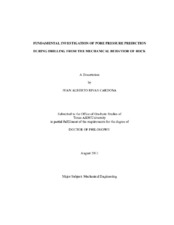| dc.description.abstract | An investigation was conducted as a preliminary effort to develop a methodology to predict pore pressure in a rock formation during drilling, for all types of rocks and situations. Specifically, it was investigated whether or not the virgin pore pressure (the pore pressure of the undisturbed rock) can be determined at the drill bit from drilling and environmental parameters, as well as solid and pore fluid properties.
Several drilling situations were analyzed to develop models relating pore pressure to drilling and environmental parameters, as well as solid and pore fluid properties. Three approaches to the modeling of such drilling situations were considered, which were used to predict pore pressure and compare the predictions to actual drilling data. The first approach used the concept of the effective stress in conjunction to the Mohr-Coulomb failure criterion. The second approach used the concept of the mechanical specific energy. The third approach made use of basic principles to relating virgin pore pressure to drilling and environmental parameters, as well as solid and pore fluid properties. This third approach resulted in the proposal of a more fundamental way of viewing mechanical specific energy (MSE) and the use of Biot's poroelasticity theory to describe the cutting process of rock.
The first approach did not provide an adequate prediction of virgin pore pressure for all types of rocks and situations. The second approach showed promising results with limited actual drilling data. A sensitivity analysis of the model resulting from the third approach indicated that pore pressure, type of rock, and back rake angle of the cutter are the most significant factors affecting the energy required to break the rock. Moreover, rate of cutting stress, depth of cut, and type of pore fluid become significant factors of the cutting process only when a low-porosity, low-permeability rock is considered.
It was concluded that there exists a relationship among pore pressure, drilling and environmental parameters, as well as solid and pore fluid properties. Therefore, it is possible in principle to determine the virgin pore pressure at the drill bit from drilling parameters, environmental parameters, and material properties. However, further work is required to establish a quantitative relationship among the significant parameters before a methodology to predict virgin pore pressure for all types of rocks and situations can be developed. | en |


